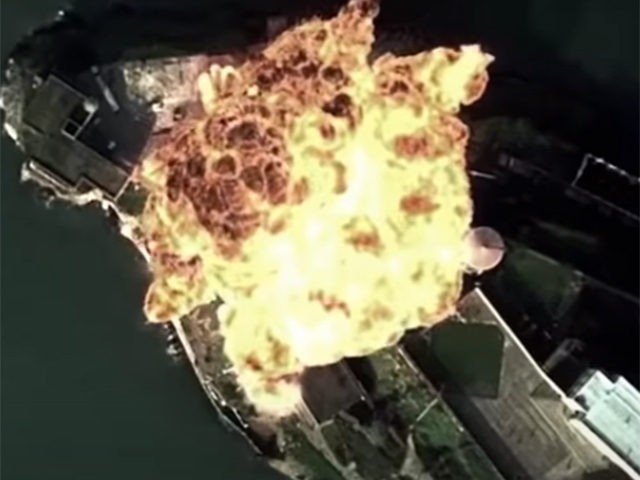Chinese state media scrambled on Tuesday to conduct geopolitical damage control over a belligerent People’s Liberation Army (PLA) propaganda video that showed Chinese warplanes destroying the U.S. airbase on Guam.
According to Chinese spin doctors, the video should be interpreted as a bit of patriotic whimsy, not evidence that China is a “bellicose country.”
China’s state-run Global Times waxed poetic about a different piece, an “inspiring music video” called “If A War Breaks Out Today” that supposedly set the hearts of Chinese subjects aflutter with patriotic fervor by illustrating the PLA’s determination to defend the “motherland” from all threats.
This video was described as such a stunning success, with “more than 60 million views as of press time Tuesday,” that it was even reposted by Chinese state media — as if that would be unusual for a propaganda production created by the regime in Beijing, especially one featuring the Communist military.
The Global Times swooned over political officers from the PLA’s Eastern Theater Command actually taking the time to respond to approving comments posted by Chinese “netizens.”
What the Chinese paper forgot to mention about this supposedly upbeat patriotic video is that it implicitly imagines the PLA attacking Taiwan. “If a war breaks out today” is a lyric from the song playing in the background. The full lyrics to that song are highly belligerent, urging the entire Chinese population to take up arms as a unified war machine to destroy enemies of the regime.
As for the even more overtly bloodthirsty video that shows the PLA destroying Guam with nuclear-capable H-6K heavy bombers — unsubtly titled “God of War H-6K, Attack!” — the Global Times attempted to dismiss its offensive content by citing “Chinese experts” who insisted it’s not offensive because everyone knows China is not “bellicose.”
Even those on-call “experts” couldn’t help concluding with threats that yes, peace-loving China will blow up Guam if the U.S. keeps working on Beijing’s nerves:
On Saturday, the PLA Air Force also released a video on its Sina Weibo account, which introduced the H-6K bomber. Reuters said on Monday that it included a scene of H-6 bombers simulating an attack on what appears to be the Andersen Air Force Base on Guam.
Chinese analysts on military affairs said Chinese citizens are the target audience, and the videos are not meant to send a message to other countries that China is looking to start a war.
The Chinese people are never bellicose people, Chinese military expert and TV commentator Song Zhongping told the Global Times on Tuesday.
“But China is facing growing external pressure, and we are living in a world that is not peaceful, particularly when countries like the US keep provoking China’s sovereignty, security and national interests,” Song said, noting that this has left China with no choice but to consider self-defense through military means.
Not only was this second propaganda video blatantly aggressive and militaristic, but in the fine tradition of rampant Chinese intellectual property theft, the PLA stole footage from several Hollywood movies to create it. Sharp-eyed critics noticed footage swiped from The Rock (1996), The Hurt Locker (2008), and Transformers: Revenge of the Fallen (2009).
A Chinese air force video showing a simulated bombing attack against a #US military base has backfired after sharp-eyed netizens realized that it contained footage lifted from #Hollywood blockbusters.
Read more: https://t.co/VFoBRn4WHh#AppleDailyENG #China #PLA pic.twitter.com/hcMBHjiT3d
— Apple Daily HK 蘋果日報 (@appledaily_hk) September 20, 2020
A good deal of mockery of the PLA ensued online for the obvious footage lifts, with some Chinese users wondering if the PLA had to use clips from American movies because its media budget had been embezzled by corrupt military officials. Others felt embarrassed that their government could not even make its own propaganda films without stealing from the Americans.
A source “close to the Chinese military” told the South China Morning Post that the pilfered images were too brief to raise any copyright concerns, the PLA has appropriated Hollywood footage before, and the lifts could be taken as a perverse form of cultural flattery.
“Almost all of the officers in the department grew up watching Hollywood movies, so in their minds, American war films have the coolest images,” the source explained.
Analysts noted the “God of War” video marks the first time the PLA has directly implied an attack on a specific U.S. target in one of its media releases. The video includes satellite images that look exactly like Guam’s Andersen Air Force Base as the target of missiles fired by a Chinese bomber pilot.
Since H-6K bombers have figured in China’s efforts to intimidate Taiwan with provocative military drills, the message seems to be that China has the reach to strike distant targets if other nations interfere with PLA military actions.
“The video is meant to warn the Americans that even supposedly safe, rearward positions such as Guam may come under threat when conflicts over regional flashpoints, be it Taiwan or South China Sea, erupt,” Colin Koh of Singapore’s Institute of Defense and Strategic Studies explained to Reuters on Monday.

COMMENTS
Please let us know if you're having issues with commenting.